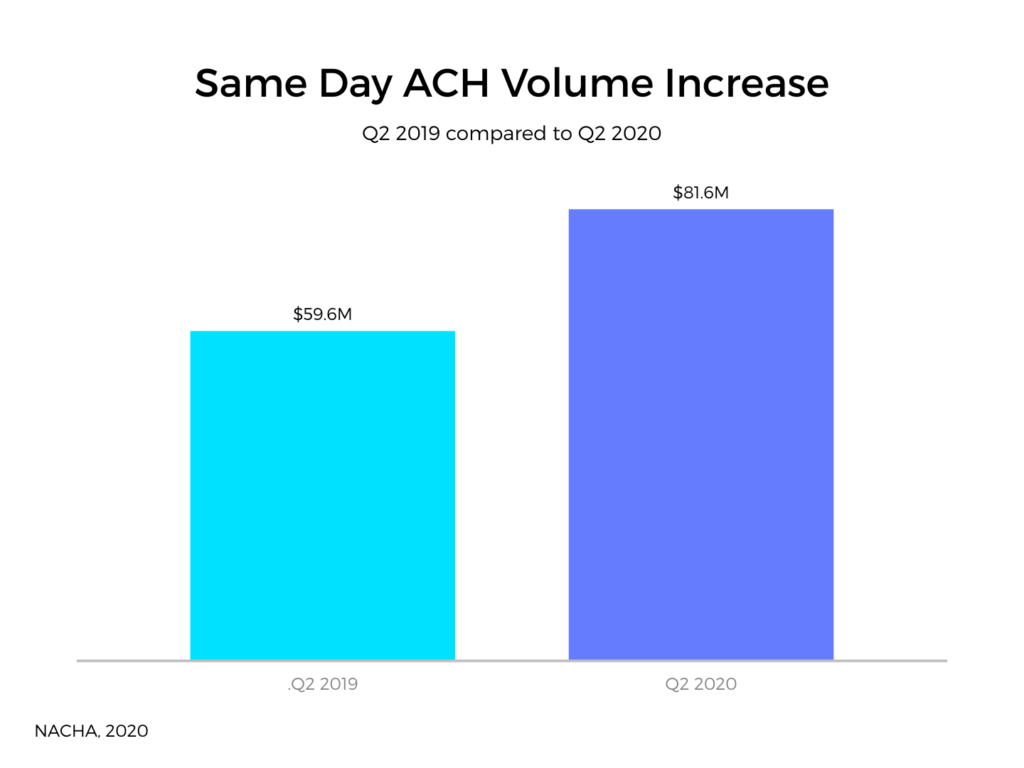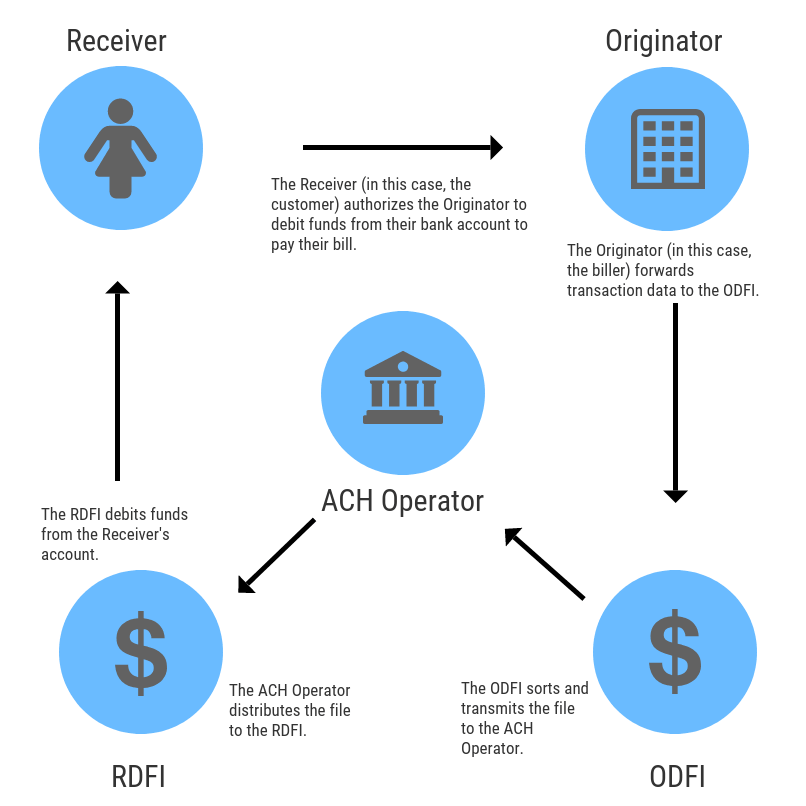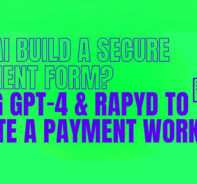A Guide to the ACH
Table of Contents
- A Guide to the ACH
- What Payment Types are Best Suited To ACH?
- How Does An Automated Clearing House (ACH) Work To Process Payments?
- The ACH Process Flow
- ACH Payments – What Are The Benefits To Merchants?
- What Merchants Need to Know about ACH Payments
- The Most Common ACH Return Codes
- NACHA Requires Merchants to Keep ACH Debit Returns Below the Following Thresholds:
- The Importance of Authorization In The Event Of A Dispute
- An ACH Authorization Form (Either Online or on Paper) Captures the Following Information
- What Fees Are Charged for Processing ACH Transactions?
- Rapyd’s Solution for US ACH Payments
How does an Automated Clearing House work? The Automated Clearing House (ACH) system is a network of financial institutions that facilitates transactions between bank accounts. Managed by the National Automated Clearing House Association (NACHA), the network processed 24.7 billion transactions with a combined worth of $55.8 trillion in 2019, transaction volume has increased more than 1 billion every year for the past 5 years and transaction value has grown more than $1 trillion for each of the last 7 years. (NACHA)


ACH payments or “direct payments” are routed through the Automated Clearing House (ACH) Network to their final destination once the account holder has authorized the payment. Unlike real-time wire transfers, ACH is a batch processing, store and forward system.
ACH operators receive entries from financial institutions in batches which are processed by a network operator three times a day. It can take up to 3 days for funds to clear a customer’s bank account.
What Payment Types are Best Suited To ACH?
ACH payments are ideal for periodic or recurring payments, such as:
- The payment of salaries
- Government benefits
- Tax refunds
Businesses looking to make payouts securely and cost effectively should be including ACH in their approach. Consumers can use ACH direct debit to pay for rent, utilities, or monthly membership subscriptions.
How Does An Automated Clearing House (ACH) Work To Process Payments?
When funds are being transferred, there is one person, company or entity that makes the payment and another that is paid. They are called the Originator and the Receiver.
Other ACH Process Terminology:
- ACH Debit or ACH direct debit – When a customer authorizes the merchant to pull the funds from their account.
- ACH Credit – If the funds are deposited or pushed into the Receiver’s account.
- Originating depository financial institution (ODFI) – the interface between the Originator and the ACH Operator (the Federal Reserve or The Clearing House) to initiate the transaction.
- Receiving depository financial institution (RDFI) – receives entries from the ACH Operator and posts them to the receiver’s account.
- ACH operator – receives the batch of ACH transactions from the originator’s ODFI. The batches are sorted and the transactions made available to the recipient’s RDFI.
The ACH Process Flow

The organization that is requesting the payment – either to send or receive funds needs the bank account information of the other party. In the above example, the Receiver initiates the transaction by granting authorization to the Originators who issue the ACH credit or debit request.
Once the authorization has been received, the Originator creates an ACH entry and sends it to the originating institution. The entry is distributed to the ACH Operator who continues the process by distributing the file to the receiving institution. At this stage, the Receiver’s account will be debited or credited depending on the type of transaction involved.
ACH Payments – What Are The Benefits To Merchants?
Although it may not suit every payment situation, especially if speed is an issue or the payment is international, ACH can be the ideal choice for many transactions.
Cost – There are a number of different parties involved in the processing of a credit card transaction. A large part of the cost is the Interchange fee set by the credit card networks. An ACH transaction deals directly with the banking network and has a much lower Interchange fee and costs merchants significantly less than a credit card transaction.
Convenience – ACH payments are electronic, so there is less paperwork for the merchant to manage and the customers can set up payments electronically on a schedule.
Customer Experience – There are customers that may not have or may not want to use their credit card for payment. ACH offers merchants an alternative payment method to offer these customers and a way of increasing sales that may not have occurred.
Chargebacks – Customers have up to 120 days to dispute a credit card payment, this is 90 days for an ACH payment. There are also only a few instances where a customer can initiate a chargeback; either the payment was never authorized or the transaction was processed earlier than authorized, or for a different amount than authorized.
What Merchants Need to Know about ACH Payments
Not instantaneous – Bank will receive transactions up until a cutoff time and then submit them all in a single batch. Unlike using the credit card network, there is no real-time authorization of funds, each stage in the process takes time. When the transaction is created on the ACH system it is “Pending”. Only when the format and information has been checked does it become “Approved”. The status is updated to “Settled” when the payment is settled with the ODFI or if a Return or a Notification of Change is received.
Delays – The timing depends on when the process is initiated relative to the cut off times at the ODFI and RDFIs. Also between those two steps, the ACH system uses net settlement to calculate the collective total of all transactions. The netting occurs between designated settlement times with the final settlement or payment after that, so settlement may take a day or days.
Return codes – An ACH return is generated by a Receiving Depository Financial Institution (RDFI) in response to an ACH transaction that has been initiated, but cannot be processed for a variety of reasons. ACH returns allow receivers and RDFIs to notify originators and ODFIs when a transaction does not go as intended. These are indicated by a three character alphanumeric return code. Most of the return codes have a two banking day turnaround time. However, unauthorized debits to consumer accounts have a 60 calendar day return time frame, during this time period a consumer can dispute a transaction as unauthorized.
The Most Common ACH Return Codes
| Return Code | Reason | What to Do | Time Frame |
| R01 | The available and/or cash reserve balance is not sufficient to cover the dollar value of the debit entry. | try the transaction again, up to two times within 30 days
Or contact the customer for a different payment method. |
2 banking days |
| R02 | The previously active account you attempted to charge is closed by the customer or RDFI. | Contact the customer for a different bank account, or payment method. | 2 banking days |
| R03 | The account number structure is valid and it passes the check digit validation, but the account number does not correspond to the individual identified in the Entry, or the account number designated is not an existing account. | Contact your customer and confirm the Routing Number, Bank Account Number and the exact name on the bank account. If everything is correct, contact your financial institution for assistance. | 2 banking days |
| R04 | The account number structure is not valid. The entry may fail the check digit validation or may contain an incorrect number of digits. | Contact your customer for the correct bank account number. | 2 banking days |
| R20 | ACH Entry to a non-transaction account. | Contact your customer and get authorization to charge a different bank account. | 2 banking days |
NACHA Requires Merchants to Keep ACH Debit Returns Below the Following Thresholds:
- Administrative Returns must stay below three percent. This % is based on prior 60 days for return reason codes: R02, R03 and R04.
- Unauthorized Returns must stay below 0.5 %. Calculated based on prior 60 days on the following return reason codes: R05, R07, R10, R29 and R51.
- Non-sufficient funds (NSF) Returns have no specific threshold but contribute to the Overall Return rate and make up the largest number of returns, by volume. NSF Returns include R01 and R09.
The Importance of Authorization In The Event Of A Dispute
Any merchant offering ACH Direct Debit as a payment method is required to obtain authorization granting permission to charge or refund the bank account for a customer or business – prior to any ACH transaction occurring.
The correct ACH authorization to process a payment protects a business in the event of a dispute. Most disputes are based on the transaction never being authorized by the account owner, or being processed earlier than the agreed date, or processing a different amount. If a customer disputes an ACH transaction, and an authorization form that specifies all of the details of the transaction was not obtained, the business could lose the dispute.
An ACH Authorization Form (Either Online or on Paper) Captures the Following Information
- Customer or business name
- Routing number
- Account number
- Amount
- Transaction type: one-time charge, refund or recurring
- If recurring, start date and frequency
What Fees Are Charged for Processing ACH Transactions?
One of the key benefits of ACH payments is their lower cost. The median internal cost of sending and receiving an ACH transfer is $0.29 USD. The cost is a combination of per-transaction and monthly fees. (Association for Financial Professionals)
- Flat fee, charged for each transaction: $0.20 – $1.50
- Percentage fee, charged for each transaction: 0.5% – 1.5%
- Monthly fee: $5 – $30
- Batch fee, charged for each batch of payments sent: < $1
- A return fee, charged for only when an ACH is returned: $2 – $5
- A reversal fee, charged for only when an ACH chargeback is required: $5 – $35
ACH offers merchants fast, secure and cost effective payment processing and makes it convenient for customers to pay for goods and services, improving cash flow and boosting profitability. But accepting ACH payments and managing the batch settlement process can be complex.
Rapyd’s Solution for US ACH Payments
Rapyd allows merchants to focus on their business by offering a simplified API experience to manage ACH payments. With global coverage Rapyd also enables collections and payments around the world – quickly and easily. Rapyd’s approach is reliable, compliant and tailored to meet your business goals domestically and worldwide.
Sources
NACHA. 2019 ACH Network Volume and Value. 2020, https://www.nacha.org/system/files/2020-02/2019-ACH-Volume-Value-Infographic-Feb%202020.pdf.
Association for Financial Professionals. “2015 AFP Payments Cost Benchmarking Survey REPORT OF SURVEY RESULTS.” https://www.afponline.org/, 2015, https://www.afponline.org/docs/default-source/default-document-library/pub/2015-payments-cost-benchmarking-report.
Subscribe Via Email
Thank You!
You’ve Been Subscribed.



